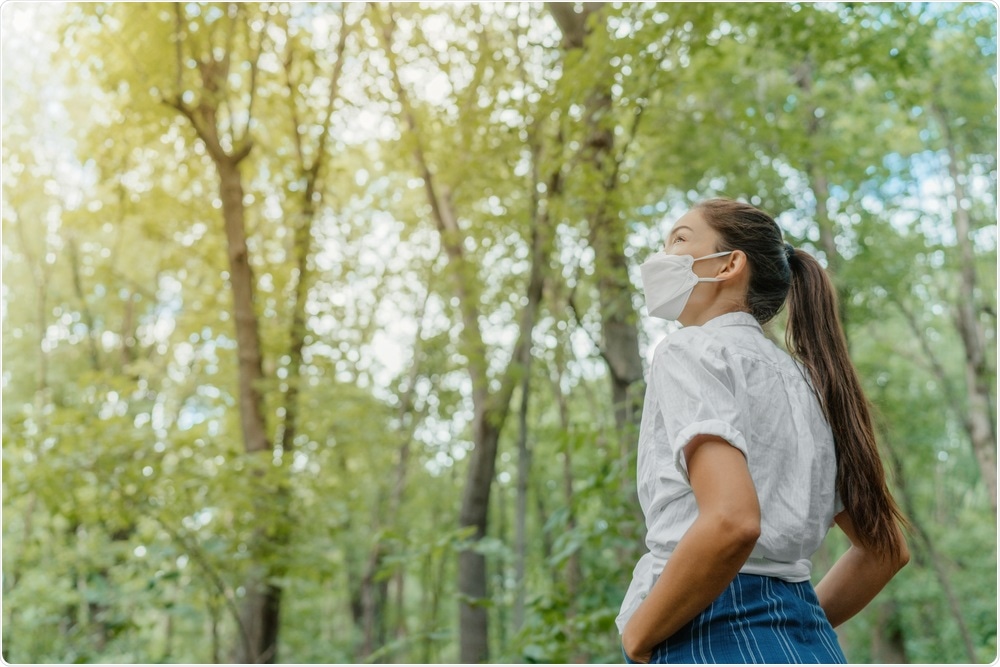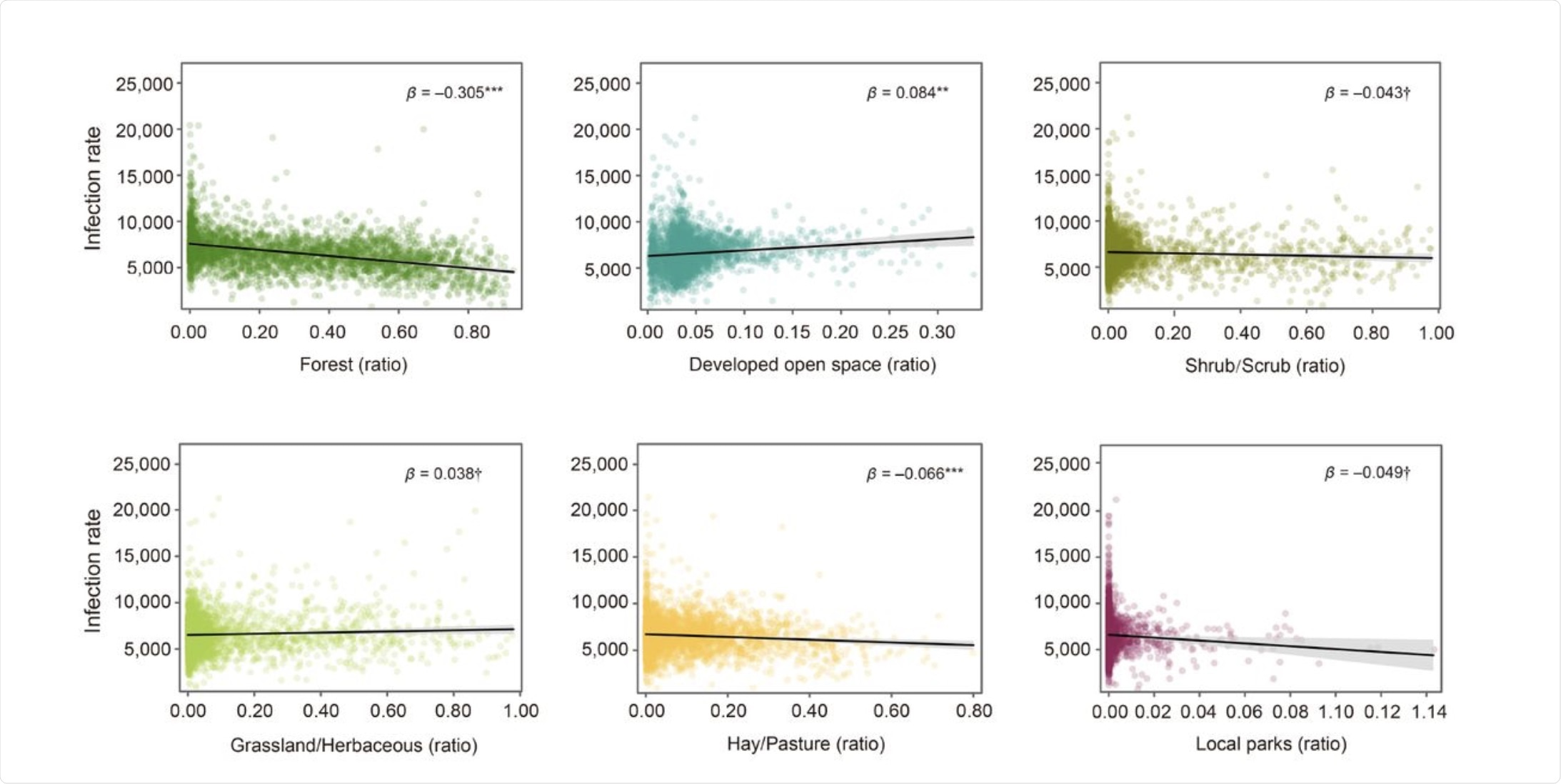An intriguing new study published on the preprint server medRxiv* reveals that the closer you are to green spaces, particularly forests, the less likely you are to be infected with the severe acute respiratory syndrome coronavirus 2 (SARS-CoV-2).
 Study: Green spaces, especially forest, linked to lower SARS-CoV-2 infection rates: A one-year nationwide study. Image Credit: Maridav / Shutterstock.com
Study: Green spaces, especially forest, linked to lower SARS-CoV-2 infection rates: A one-year nationwide study. Image Credit: Maridav / Shutterstock.com

 This news article was a review of a preliminary scientific report that had not undergone peer-review at the time of publication. Since its initial publication, the scientific report has now been peer reviewed and accepted for publication in a Scientific Journal. Links to the preliminary and peer-reviewed reports are available in the Sources section at the bottom of this article. View Sources
This news article was a review of a preliminary scientific report that had not undergone peer-review at the time of publication. Since its initial publication, the scientific report has now been peer reviewed and accepted for publication in a Scientific Journal. Links to the preliminary and peer-reviewed reports are available in the Sources section at the bottom of this article. View Sources
Background
The coronavirus disease 2019 (COVID-19), which is the disease caused by infection from SARS-CoV-2, produced a crisis in both the global health and economic sectors. Many earlier studies examined the correlation of COVID-19 with temperature, humidity, climate, demographic factors, and architecture. However, few have examined the relationship between COVID-19 and natural green spaces, particularly forests.
An increasing number of studies have found that green spaces reduce the risk of infection and that buildings and other architectural living spaces made for human enjoyment or efficiency are actually exposing us to higher infection risks. The current study discusses how green spaces enhance protection against SARS-CoV-2 and different ways in which these findings can be used to shape new policies and public health interventions.
Several different researchers have confirmed the beneficial effects of green spaces to mental, physical, and social health. These effects may be due to the reduction in mental stress and tiredness, combined with the improved social bonds and enhanced physical activity, provided in green spaces. The visual thrill accompanied by birdsongs and crickets is also not negligible.
What were the findings?
The authors of the current study found that forests and pastures are inversely associated with SARS-CoV-2. Comparably, the infection rates are the lowest with developed open spaces, especially forests.
The beneficial effects of green spaces are consistent across all levels of urbanization. However, the highest effect was associated with urbanization level 3, or mid-level environments, with both extremes showing the lowest explanatory power for this effect. Across all levels, forests maintained their correlation with lower infection rates.
Similarly, forest space reduced infection rates, regardless of when the data was collected between January 22 to March 30, 2020. Importantly, in other green spaces, the effect increases from significantly small to large effects across the five time periods of the pandemic.
Even after controlling for all confounding factors, the effect of forests on infection rates continued to be markedly negative at almost all levels of urbanicity, but strongest at level 3. The closer the forest was, the lower the infection rate, with the beginning of the association observable when the forest was within 100 meters and increasing thereafter. Beyond 1.4 kilometers (km), however, the increase subsided, thereby indicating that exposure to forest space within 1-1.4 km is linked to the lowest infection rates.
 Relationships between each of the six types of green spaces and SARS-CoV-2 infection rates. Each green space factor ratio is calculated by dividing green space area by the total area of the county. Shaded areas represent pointwise 95% confidence intervals, points represent partial residuals. Lines represent the linear trend line. Note: ⴕ p < 0.05; * p < 0.01; ** p < 0.001; *** p < 0.0001.
Relationships between each of the six types of green spaces and SARS-CoV-2 infection rates. Each green space factor ratio is calculated by dividing green space area by the total area of the county. Shaded areas represent pointwise 95% confidence intervals, points represent partial residuals. Lines represent the linear trend line. Note: ⴕ p < 0.05; * p < 0.01; ** p < 0.001; *** p < 0.0001.
Mechanism of reduction
Being outdoors has long been recognized to reduce viral transmission rates. This is probably due to the much greater movement of air and consequent lowering of viral concentrations, as well as a lower concentration of people. These factors, therefore, tend to reduce the spread of viruses by aerosols and respiratory droplets. In fact, most infection clusters with SARS-CoV-2 occur indoors.
The availability of green space within easy walking distance encourages outdoor activities, with some studies reporting that 90% more users come to green public spaces as compared to barren ones. Since social interactions cannot be suppressed for long, it is better to make such public spaces available for socializing with safety in an effort to reduce time indoors and, subsequently, the risk of infection.
Physical activity itself reduces the risk of obesity and of being overweight, while also enhancing general health and immune capability, both of which reduce the individual’s susceptibility to SARS-CoV-2. Moreover, the mental relaxation and healthy attention to nature induced by a green space may contribute to the toning of immune function, as shown by several researchers.
Social interactions and community behaviors also tend to improve in terms of less impulsivity and better social connections when there is free access to green spaces. Community health is also seen to rise to a higher standard, even when the community is composed of rich and poor, old and young, or different races.
Social collaborative behavior, such as is required for mask-wearing and social distancing, as well as cohesion and support, tend to grow in such communities. Thus, green spaces help to reduce the overall incidence of COVID-19.
Finally, green spaces reduce air pollution, improve health, and indirectly reduce the expression of angiotensin-converting enzyme 2 (ACE2), which is the cell receptor that SARs-CoV-2 binds to in vivo.
The special place of forest
Forest space, whether large or small, allows more social distancing, as shown in previous studies. Secondly, these spaces provide a better microclimate as compared to urban parks due to the overshadowing of trees. Thirdly, the shade encourages longer outdoor time.
Some researchers claim that plant-derived organic compounds stimulate immunity, modulate autonomic nervous activity, and reduce blood pressure. These compounds also increase natural killer (NK) cell number and function, thus boosting innate immunity. The complex profile of different textures, shapes, and levels in forests also encourages and accommodates stressed and tired people to relax and let go of their tension.
The level of pollution removed by a forest is greater than that with a comparable open space. In fact, forest trees were estimated to have removed 17.4 million tons of air pollutants in 2021, thus saving 850 lives and preventing 670,000 cases of acute respiratory illness.
What are the implications?
The current study makes it clear that forest patches, at least, must be conserved and built in every residential neighborhood to encourage good health and resistance to pathogens, especially SARS-CoV-2. This has the appeal of reducing the burden on healthcare systems to hospitalizations, particularly those due to COVID-19.
The reduction in COVID-19 rates and its correlation to the availability of green spaces confirms this to be a valuable association, even after controlling for numerous confounding factors such as political events and the number of frontline or essential workers.
“Preserving and developing forests and other green spaces might be important to alleviate the infection risk. Moreover, it is critical to preserve and develop forests within walking distance of populations, to optimize the effects of forests on SARS-CoV-2 infection risks and maximize other potential health benefits for people.”

 This news article was a review of a preliminary scientific report that had not undergone peer-review at the time of publication. Since its initial publication, the scientific report has now been peer reviewed and accepted for publication in a Scientific Journal. Links to the preliminary and peer-reviewed reports are available in the Sources section at the bottom of this article. View Sources
This news article was a review of a preliminary scientific report that had not undergone peer-review at the time of publication. Since its initial publication, the scientific report has now been peer reviewed and accepted for publication in a Scientific Journal. Links to the preliminary and peer-reviewed reports are available in the Sources section at the bottom of this article. View Sources
Journal references:
- Preliminary scientific report.
Jiang, B., Yang, Y., Chen, L., et al. (20219). Green spaces, especially forest, linked to lower SARS-CoV-2 infection rates: A one-year nationwide study. medRxiv. doi:10.1101/2021.08.04.21261420. https://www.medrxiv.org/content/10.1101/2021.08.04.21261420v1.
- Peer reviewed and published scientific report.
Jiang, Bin, Yuwen Yang, Long Chen, Xueming Liu, Xueying Wu, Bin Chen, Chris Webster, et al. 2022. “Green Spaces, Especially Nearby Forest, May Reduce the SARS-CoV-2 Infection Rate: A Nationwide Study in the United States.” Landscape and Urban Planning 228 (December): 104583. https://doi.org/10.1016/j.landurbplan.2022.104583. https://www.sciencedirect.com/science/article/pii/S0169204622002328.
Article Revisions
- Apr 11 2023 - The preprint preliminary research paper that this article was based upon was accepted for publication in a peer-reviewed Scientific Journal. This article was edited accordingly to include a link to the final peer-reviewed paper, now shown in the sources section.